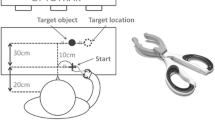Abstract
Objects can be grasped in several ways due to their physical properties, the context surrounding the object, and the goal of the grasping agent. The aim of the present study was to investigate whether the prior-to-contact grasping kinematics of the same object vary as a result of different goals of the person grasping it. Subjects were requested to reach toward and grasp a bottle filled with water, and then complete one of the following tasks: (1) Grasp it without performing any subsequent action; (2) Lift and throw it; (3) Pour the water into a container; (4) Place it accurately on a target area; (5) Pass it to another person. We measured the angular excursions at both metacarpal-phalangeal (mcp) and proximal interphalangeal (pip) joints of all digits, and abduction angles of adjacent digit pairs by means of resistive sensors embedded in a glove. The results showed that the presence and the nature of the task to be performed following grasping affect the positioning of the fingers during the reaching phase. We contend that a one-to-one association between a sensory stimulus and a motor response does not capture all the aspects involved in grasping. The theoretical approach within which we frame our discussion considers internal models of anticipatory control which may provide a suitable explanation of our results.




Similar content being viewed by others
Notes
We thank an anonymous reviewer for suggesting this alternative explanation.
References
Ansuini C, Santello M, Massaccesi S, Castiello U (2006) Effects of end-goal on hand shaping. J Neurophysiol 95:2456–2465
Armbrüster C, Spijkers W (2006) Movement planning in prehension: do intended actions influence the initial reach and grasp movement? Motor Control 10:311–329
Bootsma RJ, Marteniuk RG, Mackenzie CL, Zaal FTJM (1994) The speed-accuracy trade-off in manual prehension: effects of movement amplitude, object size and object width on kinematic characteristics. Exp Brain Res 98:535–541
Castiello U (2005) The neuroscience of grasping. Nat Rev Neurosci 6:726–736
Cohen RG, Rosenbaum DA (2004) Where grasps are made reveals how grasps are planned: generation and recall of motor plans. Exp Brain Res 157:486–495
Eastough D, Edwards MG (2007) Movement kinematics in prehension are affected by grasping objects of different mass. Exp Brain Res 176:193–198
Fitts PM (1954) The information capacity of the human motor system in controlling the amplitude of a movement. J Exp Psychol 47:381–391
Flanagan JR, Nakano E, Imamizu H, Osu R, Yoshioka T, Kawato M (1999) Composition and decomposition of internal models in motor learning under altered kinematic and dynamic environments. J Neurosci 19:RC34(1–5)
Gao F, Latash ML, Zatsiorsky VM (2006) Maintaining rotational equilibrium during object manipulation: linear behavior of a highly non-linear system. Exp Brain Res 169:519–531
Gentilucci M, Castiello U, Corradini ML, Scarpa M, Umiltà C, Rizzolatti G (1991) Influence of different types of grasping on the transport component of prehension movements. Neuropsychologia 29:361–378
Gentilucci M, Negrotti A, Cangitano M (1997) Planning an action. Exp Brain Res 115:116–128
Ghahramani Z, Wolpert DM (1997) Modular decomposition in visuomotor learning. Nature 386:392–395
Jakobson LS, Goodale MA (1991) Factors affecting higher-order movement planning: a kinematic analysis of human prehension. Exp Brain Res 86:199–208
Johansson RS, Westling G, Backstrom A, Flanagan JR (2001) Eye-hand coordination in object manipulation. J Neurosci 21:6917–6932
Johnson-Frey SH, McCarty ME, Keen R (2004) Reaching beyond spatial perception: effects of intended future actions on visually guided prehension. Vis Cogn 11:371–399
Kawato M (1999) Internal models for motor control and trajectory planning. Curr Opin Neurobiol 9:718–727
Kinoshita H, Kawai S, Ikuta K (1995) Contributions and co-ordination of individual fingers in multiple finger prehension. Ergonomics 38:1212–1230
Land M, Mennie N, Rusted J (1999) The roles of vision and eye movements in the control of activities in daily living. Perception 28:1311–1328
Lukos J, Ansuini C, Santello M (2007) Choice of contact points during multidigit grasping: effect of predictability of object center of mass location. J Neurosci 27:3894–3903
Marteniuk RG, MacKenzie CL, Jeannerod M, Athenes S, Dugas C (1987) Constraints on human arm movement trajectories. Can J Psychol 41:365–378
Napier JR (1956) The prehensile movements of the human hand. J Bone Joint Surg Am 38:902–913
Smeets JB, Hayhoe MM, Ballard DH (1996) Goal-directed arm movements change eye-head coordination. Exp Brain Res 109:434–440
Wolpert DM, Ghahramani Z (2000) Computational principles of movement neuroscience. Nat Neurosci 3:1212–1217
Wolpert DM, Kawato M (1998) Multiple paired forward and inverse models for motor control. Neural Netw 11:1317–1329
Zatsiorsky VM, Gao F, Latash ML (2003) Prehension synergies: effects of object geometry and prescribed torques. Exp Brain Res 148:77–87
Acknowledgments
We would like to thank Federico Tubaldi for his comment on an earlier version of the manuscript and Stefano Massaccesi for his technical support. This work was supported by a research grant from the Italian Ministry of Research (MUR) to UC.
Author information
Authors and Affiliations
Corresponding author
Rights and permissions
About this article
Cite this article
Ansuini, C., Giosa, L., Turella, L. et al. An object for an action, the same object for other actions: effects on hand shaping. Exp Brain Res 185, 111–119 (2008). https://doi.org/10.1007/s00221-007-1136-4
Received:
Accepted:
Published:
Issue Date:
DOI: https://doi.org/10.1007/s00221-007-1136-4




